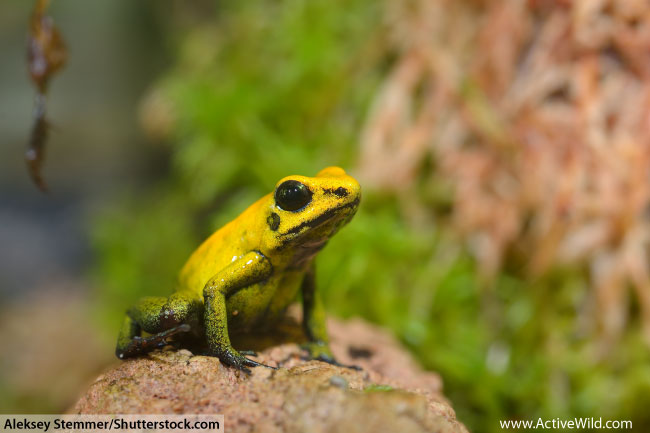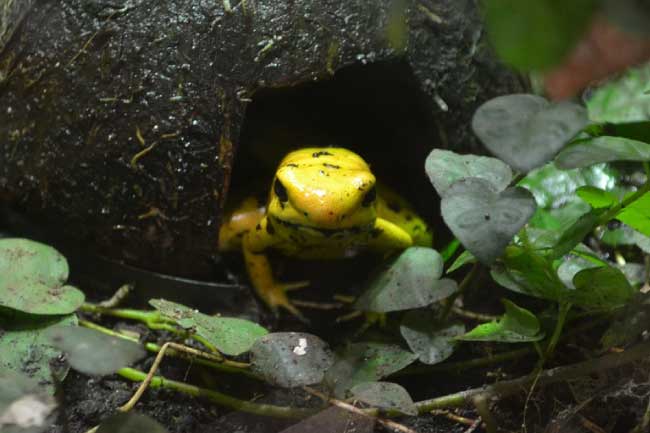This page contains amazing golden poison frog facts for kids (and adults). This animal is part of the Active Wild Online Zoo, where you can find information, pictures and videos of all your favorite animals!
Golden Poison Frog Quick Facts
- Other Name(s): Golden Frog, Golden poison arrow frog, Golden dart frog
- Scientific name: Phyllobates terribillis
- Type of Animal: Amphibian
- Animal Family: Dendrobatidae
- Where Found: Pacific coast of Colombia
- Average Life span: 10 years
- Length: 1 to 2in (2.5 to 5cm)
- Weight: Less than 1oz (28 g)
- Conservation Status: Endangered
- Interesting fact: The only natural predator of the golden poison dart frog is Leimadophis epinephelus, a snake that has developed resistance to the frog's deadly poison.
Golden Poison Frog Video
You can learn about the golden poison frog, and efforts being made to save this endangered amphibian, in the video below:
Meet The Golden Poison Frog: Introduction
The golden poison frog is native to a small area on the Pacific coast of Colombia. Despite being only the size of a paper clip, this tiny amphibian is considered one of the deadliest animals on earth.
Where Does The Golden Poison Frog Live?
The golden poison frog inhabits rainforests with high rainfall and humidity and a temperature of least 26°C (82.4°F).
It is terrestrial (ground-living), preferring to be on the forest floor or on plants a few centimeters above the ground.
How To Recognize a Golden Poison Frog
Golden poison frogs are very brightly colored with large black eyes. They grow to a length of 1-2in (2.5-5cm) and adult females are typically larger than males. Unlike many frogs, the golden poison frog is active during the day.
Although yellow is the most common color seen, they are found in varying shades of yellow, orange and green. In nature, bright colors are often a warning sign to ward off potential predators.
What Does a Golden Poison Frog Eat?
The golden poison frog mainly eats ants, but will also eat other insects that are commonly found on the rainforest floor, such as termites, beetles and crickets.
The golden poison frog uses its long, adhesive tongue to catch food.
Family Groups & Breeding
The golden poison frog is a social animal, living in groups that contain an average of 6 members. Once or twice a year the frogs come together in large numbers to breed.
The females lay their eggs on the forest floor. The eggs hatch in two weeks, and the tadpoles attach themselves to sticky mucous on the male frog’s back.
The male frog then carries the tadpoles into the trees, depositing them in pools formed in the leaves of bromeliad plants. Here the tadpoles will undergo metamorphosis and become frogs. At this point the parents lead them to a permanent family group.
- You can find out about bromeliads here: Rainforest Plants.
Communication
The golden poison frog uses distinct calls and movements as ways of communication. At breeding times, males attract females by using a variety of high pitched calls. In addition, a push-up movement is a sign of dominance, while lowering the head is a signal of submission.
The Poison of the Golden Poison Frog
The skin of the golden poison frog is densely coated in a toxin called batrachotoxin. The frog uses this toxin for self-defense; not for killing its prey.
A single golden poison frog has enough poison to kill ten humans or up to 10, 000 mice! The poison prevents the victim’s nerves from transmitting signals, which causes paralysis and heart failure.
Scientists are unsure exactly how the golden poison frog produces this incredibly potent toxin. It is thought that the ‘ingredients’ for the poison come from one of the insects the frog eats.
A golden poison frog that is raised in captivity and is not fed insects from its native habitat does not develop the poison.
Indigenous people
Indigenous (native) people that live in the Colombian rainforests have used the frog’s poison on the tips of their blowgun darts for centuries. Incredibly the poison-soaked tips can remain potent for years.
Is The Golden Poison Frog Endangered?
The deforestation has led to the species being rated as “endangered” by the IUCN. The golden poison frog is likely to become extinct if its natural habitat is not protected.
There has been widespread destruction of the rainforests in which the golden poison frog lives, caused primarily by human development and changing farming practices.
Golden Poison Frog Facts For Kids: Questions
Q1. Where can the golden poison frog be found?
- a) Pacific coast of Peru
- b) Pacific coast of Colombia
- c) Pacific coast of Ecuador
Q2. What is the natural habitat of the golden poison frog?
- a) Desert
- b) Swamps
- c) Rainforest
Q3. What type of animal is the golden poison frog?
- a) Reptile
- b) Amphibian
- c) Mammal
Now see more amazing animals in the Active Wild Online Zoo!
Visit a world-class zoo ... without leaving your home! At the Active Wild Online Zoo you'll find FREE pictures, facts and information on the world's most incredible animals. Each page also features a specially chosen video, and a list of questions to test your knowledge!
Golden Poison Frog Facts For Kids: Answers
Q1) b, Q2) c, Q3) b






Do you have a page for the red panda?
Yes! Here: Red Panda Facts
You can use the search at the top of the page under the menu to search for any animal 🙂
i cant find the black panther
Hi,
thanks for letting us know. We’ll try to cover panthers in detail in a future article, but for now here’s some quick info …
A panther isn’t a separate species.
A panther is any big cat with a mutation that has caused the over-production of black pigment in its skin.
A leopard can be a panther, as can a jaguar.
I hope this helps!
this website is the best
Thanks Yahaira! 🙂
you are welcome